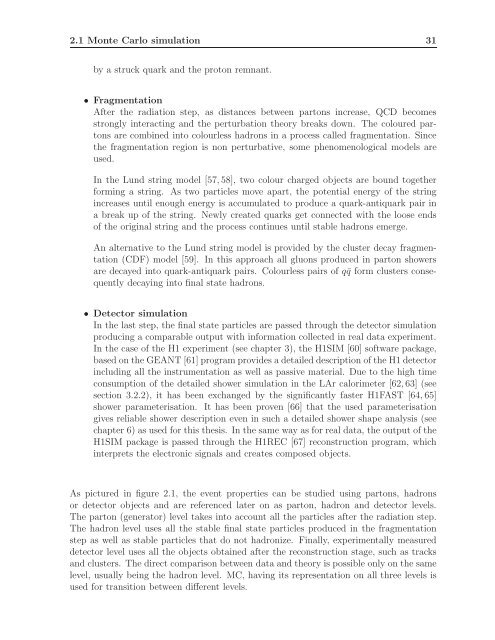10 - H1 - Desy
10 - H1 - Desy
10 - H1 - Desy
Create successful ePaper yourself
Turn your PDF publications into a flip-book with our unique Google optimized e-Paper software.
2.1 Monte Carlo simulation 31<br />
by a struck quark and the proton remnant.<br />
• Fragmentation<br />
After the radiation step, as distances between partons increase, QCD becomes<br />
strongly interacting and the perturbation theory breaks down. The coloured partons<br />
are combined into colourless hadrons in a process called fragmentation. Since<br />
the fragmentation region is non perturbative, some phenomenological models are<br />
used.<br />
In the Lund string model [57,58], two colour charged objects are bound together<br />
forming a string. As two particles move apart, the potential energy of the string<br />
increases until enough energy is accumulated to produce a quark-antiquark pair in<br />
a break up of the string. Newly created quarks get connected with the loose ends<br />
of the original string and the process continues until stable hadrons emerge.<br />
An alternative to the Lund string model is provided by the cluster decay fragmentation<br />
(CDF) model [59]. In this approach all gluons produced in parton showers<br />
are decayed into quark-antiquark pairs. Colourless pairs of q¯q form clusters consequently<br />
decaying into final state hadrons.<br />
• Detector simulation<br />
In the last step, the final state particles are passed through the detector simulation<br />
producing a comparable output with information collected in real data experiment.<br />
In the case of the <strong>H1</strong> experiment (see chapter 3), the <strong>H1</strong>SIM [60] software package,<br />
based on the GEANT [61] program provides a detailed description of the <strong>H1</strong> detector<br />
including all the instrumentation as well as passive material. Due to the high time<br />
consumption of the detailed shower simulation in the LAr calorimeter [62,63] (see<br />
section 3.2.2), it has been exchanged by the significantly faster <strong>H1</strong>FAST [64, 65]<br />
shower parameterisation. It has been proven [66] that the used parameterisation<br />
gives reliable shower description even in such a detailed shower shape analysis (see<br />
chapter 6) as used for this thesis. In the same way as for real data, the output of the<br />
<strong>H1</strong>SIM package is passed through the <strong>H1</strong>REC [67] reconstruction program, which<br />
interprets the electronic signals and creates composed objects.<br />
As pictured in figure 2.1, the event properties can be studied using partons, hadrons<br />
or detector objects and are referenced later on as parton, hadron and detector levels.<br />
The parton (generator) level takes into account all the particles after the radiation step.<br />
The hadron level uses all the stable final state particles produced in the fragmentation<br />
step as well as stable particles that do not hadronize. Finally, experimentally measured<br />
detector level uses all the objects obtained after the reconstruction stage, such as tracks<br />
and clusters. The direct comparison between data and theory is possible only on the same<br />
level, usually being the hadron level. MC, having its representation on all three levels is<br />
used for transition between different levels.
















